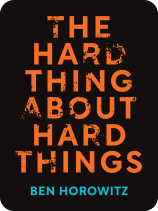

This article is an excerpt from the Shortform book guide to "The Hard Thing About Hard Things" by Ben Horowitz. Shortform has the world's best summaries and analyses of books you should be reading.
Like this article? Sign up for a free trial here .
What are the roles and responsibilities of a CEO? What qualities make a good CEO?
A good CEO should be able to do three things well: articulate their vision, get the team to work on the vision, and achieve results. The role of a CEO is also to be a good decision-maker and to have the courage to do what is necessary, even if it’s difficult.
Keep reading about the roles and responsibilities of a CEO.
CEO Responsibilities
The most important responsibility of a CEO is leadership. You can measure a leader by the quantity and quality of people who want to follow her.
In practice, people want to follow leaders who do three things well:
- Know what to do—articulate the vision and make decisions
- Get the team to work on the vision
- Achieve results
We’ll cover each in more detail.
Know What to Do
Knowing what to do consists of two activities: articulating the vision and making decisions to achieve the vision.
Articulating the Vision
The vision is the story for what the company is capable of doing and why it’s exciting to work on. It’s also the strategy behind how the company can achieve this vision. It answers the deepest questions of why: “Why is this important to build? Why is the world better off because of our work? Why should I work here instead of anywhere else?”
A compelling vision has multiple benefits:
- It gets talented people (who have the choice of working anywhere) to work for you.
- It retains those people when your company struggles. They could easily leave for another job, but they stay because the vision compels them.
- It aligns the entire team to make decisions in the same direction.
- It motivates the team.
The CEO is responsible for articulating the vision. She doesn’t have to have originated the vision, but she needs to be its spokesperson and protector.
Steve Jobs was a master at this, getting people to follow him to his computing company NeXT in the 1980s, then getting people motivated at the failing Apple when he returned in 1997. Amazon’s Jeff Bezos also frequently communicates the company’s long-term vision around customer focus, as he did in this shareholder letter in 1997.
Making Decisions
Just as engineers output code and marketers output advertisements, the CEO outputs decisions. A good CEO makes high-quality decisions quickly.
Making decisions requires a few key activities:
- Ponder the important questions: What are we good at, and how do we get better? What’s the most important thing we’re not doing? What are our competitors doing? Is our company healthy? Is our team happy?
- Gather information voraciously. Get information broadly, from your employees, customers, competitors, and outsiders. Make information gathering a central part of your day, from private reading to staff meetings and one-on-ones.
- Be bold. You will never have enough information to make a decision with complete confidence. Your decisions may be unpopular with your team. You need to make them anyway. Often waiting to make a decision is worse.
Get the Team to Work on the Vision
A compelling vision is well and good, but to make it real, you need a team to build toward it. This means hiring great people, then getting them to do good work.
The best way to accomplish both is to make your company a great place to work, which has been the subject of the past few chapters. In review, a great place to work requires these attributes of the CEO, the company, and the culture:
- People trust the CEO to take care of them. The CEO has the right kind of ambition—to push the team’s success over her own personal success. Over time, people come to see the company as their own and call it “my company.”
- People are clear on what their jobs are and how success is measured.
- People believe their work makes a difference to the success of the company and, by extension, to their personal success. The compensation scheme and promotion processes are fair and reward actual contributions, not politics.
- They have as few barriers to getting work done as possible. They don’t have to deal with office politics and overly bureaucratic processes.
- People enjoy working with the people around them. People clearly pull their own weight; the ones who don’t are regularly removed from the team.
Achieve Results
Having defined a vision and made progress toward the vision, ideally you’ve achieved the results you were looking for.
But what are “good” results? It depends on the size and nature of the opportunity, which are idiosyncratic to each company.
Therefore, you should measure your results against your own company’s opportunity, not anyone else’s company. It doesn’t make sense for a fruit vendor to grow as quickly as Facebook did. It doesn’t make sense for a hardware company to have margins as good as a software company. Hoping otherwise can be destructive.
Improve Your Weakness
All CEOs have different strengths and weaknesses along these three activities. A deep strength in one area can temporarily compensate for another—a CEO with a blindingly bright vision can attract people even if the organization is a mess. A CEO who achieves results can be a less articulate communicator of the vision.
However, you should find your weakness and work on it.
The Importance of Courage
To be a good CEO, you need to be both intelligent and courageous. Intelligence helps you find the right decision to make. Courage helps you execute the decision, even when it’s terrifying.
Decisions can be terrifying for a few reasons:
- You don’t have enough information to know whether it’ll work. At best, you might have only 10% of the information that a business school case study has.
- The decision is unpopular with the team. While it may produce long-term benefits, it can cause deep short-term costs, such as layoffs of entire departments or rebuilding the company’s capabilities. You may face tremendous social pressure against the decision you want to make.
- The consequences of making the wrong decision are severe. It might mean the life and death of your company. This only gets worse as the company grows.
Intel CEO Andy Grove faced all three. Through the 1970s, Intel’s main business line was in memory chips (employing 80% of its headcount), but in the early 1980s, Japanese companies began dumping chips at bargain prices. Grove knew the memory industry was done and jettisoned the memory business to go into microprocessors for personal computers. This was deeply unpopular at the time with both employees and investors, but it turned out to be one of the great decisions in business history.
A courageous CEO makes the right decision, no matter how hard it is. To paraphrase boxing trainer Cus D’Amato: The difference between a hero and a coward is not what they feel. They’re both terrified. But the coward runs away from that fear. The hero fights off the fear to do what she has to do.
Like any other skill, courage can be developed. You face decisions everyday between doing what’s easy, consensus, and wrong and what’s hard, contrarian, and right. Each time you make the hard choice, you will become a little more courageous.

———End of Preview———
Like what you just read? Read the rest of the world's best book summary and analysis of Ben Horowitz's "The Hard Thing About Hard Things" at Shortform .
Here's what you'll find in our full The Hard Thing About Hard Things summary :
- What it was like to head a company through the dotcom bubble and subsequent burst
- Why failing is normal
- How to build a good place to work






